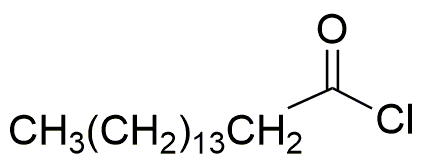Palmitoyl chloride is widely utilized in research focused on various applications:
- Surfactant Production: It serves as a key ingredient in the formulation of surfactants, which are essential in the cosmetic and personal care industry for emulsifying and stabilizing products.
- Pharmaceutical Synthesis: This compound is used in the synthesis of pharmaceutical intermediates, enhancing drug formulations and improving bioavailability in medicinal applications.
- Bioconjugation: In biochemistry, palmitoyl chloride is employed for attaching palmitic acid to proteins or peptides, which can enhance their stability and cellular uptake in drug delivery systems.
- Polymer Chemistry: It is utilized in the production of specialty polymers, providing unique properties such as increased hydrophobicity and thermal stability, beneficial for coatings and adhesives.
- Food Industry Applications: In food science, it can be used as a flavoring agent or preservative, contributing to the stability and shelf-life of various food products.
General Information
Properties
Safety and Regulations
Applications
Palmitoyl chloride is widely utilized in research focused on various applications:
- Surfactant Production: It serves as a key ingredient in the formulation of surfactants, which are essential in the cosmetic and personal care industry for emulsifying and stabilizing products.
- Pharmaceutical Synthesis: This compound is used in the synthesis of pharmaceutical intermediates, enhancing drug formulations and improving bioavailability in medicinal applications.
- Bioconjugation: In biochemistry, palmitoyl chloride is employed for attaching palmitic acid to proteins or peptides, which can enhance their stability and cellular uptake in drug delivery systems.
- Polymer Chemistry: It is utilized in the production of specialty polymers, providing unique properties such as increased hydrophobicity and thermal stability, beneficial for coatings and adhesives.
- Food Industry Applications: In food science, it can be used as a flavoring agent or preservative, contributing to the stability and shelf-life of various food products.
Documents
Safety Data Sheets (SDS)
The SDS provides comprehensive safety information on handling, storage, and disposal of the product.
Product Specification (PS)
The PS provides a comprehensive breakdown of the product’s properties, including chemical composition, physical state, purity, and storage requirements. It also details acceptable quality ranges and the product's intended applications.
Certificates of Analysis (COA)
Search for Certificates of Analysis (COA) by entering the products Lot Number. Lot and Batch Numbers can be found on a product’s label following the words ‘Lot’ or ‘Batch’.
*Catalog Number
*Lot Number
Certificates Of Origin (COO)
This COO confirms the country where the product was manufactured, and also details the materials and components used in it and whether it is derived from natural, synthetic, or other specific sources. This certificate may be required for customs, trade, and regulatory compliance.
*Catalog Number
*Lot Number
Safety Data Sheets (SDS)
The SDS provides comprehensive safety information on handling, storage, and disposal of the product.
DownloadProduct Specification (PS)
The PS provides a comprehensive breakdown of the product’s properties, including chemical composition, physical state, purity, and storage requirements. It also details acceptable quality ranges and the product's intended applications.
DownloadCertificates of Analysis (COA)
Search for Certificates of Analysis (COA) by entering the products Lot Number. Lot and Batch Numbers can be found on a product’s label following the words ‘Lot’ or ‘Batch’.
*Catalog Number
*Lot Number
Certificates Of Origin (COO)
This COO confirms the country where the product was manufactured, and also details the materials and components used in it and whether it is derived from natural, synthetic, or other specific sources. This certificate may be required for customs, trade, and regulatory compliance.

